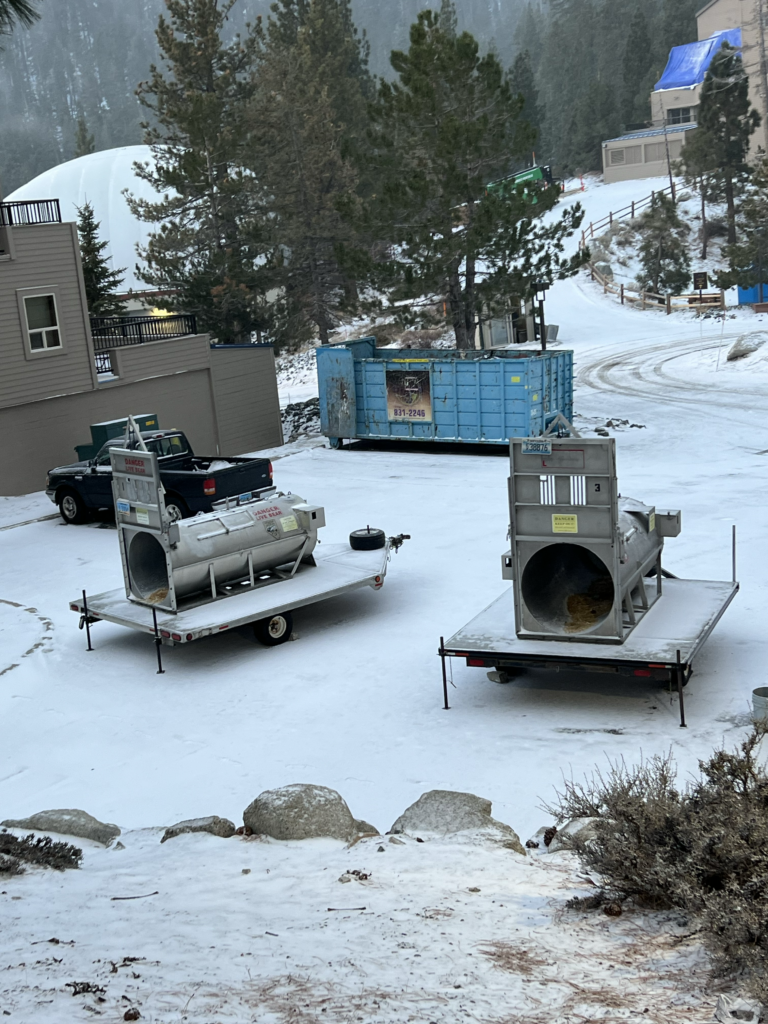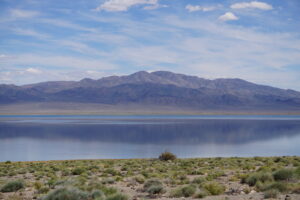5:30
News Story
Killing for fun: Animal advocates seek end to bear hunt
Wildlife policy dictated by small minority, say critics
5:30
News Story
Killing for fun: Animal advocates seek end to bear hunt
Wildlife policy dictated by small minority, say critics
Critics suggest the Nevada Department of Wildlife's bear management practices indicate the agency allows tourism to drive policy, and disregards the effect on wildlife. (Photo courtesy Dr. Staci Baker)
Critics suggest the Nevada Department of Wildlife's bear management practices indicate the agency allows tourism to drive policy, and disregards the effect on wildlife. (Photo courtesy Dr. Staci Baker)
The killing of two mother bears during Nevada’s 2023 bear hunt is fueling calls from animal advocates for an end to the state’s for-sport hunt, or a decrease in the annual quota that allows 50 bears to be killed each year. They’re also asking the state’s Wildlife Commission, which meets Friday, to prohibit hounding, the practice of setting a pack of dogs loose to chase a bear until it climbs a tree out of fear and exhaustion, rendering it an easy target.
A mortality report from the Nevada Department of Wildlife says a bear killed on Nov. 4 was a nursing mother. The hunter reported spotting two cubs in a nearby tree, who were likely orphaned by the killing, experts say.
However, a mortality report from NDOW says an investigation resulted in “no finding that sow was shot while accompanied by cubs.” The agency made no effort to retrieve the cubs, calling the sighting an unrelated incident.
“Currently, it’s legal in Nevada to kill a mother bear of dependent cubs, as long as you don’t see her with the cubs,” says activist Kathryn Bricker of No Bear Hunt NV. ”Mother bears’ behavior is documented to be the same. When they are under the pursuit of dogs, they put their cubs in a tree for safety, and they continue running as decoys.”
NDOW determined another bear, killed on Nov. 16, had offspring “likely this year,” according to the agency’s mortality report.
“I had not heard of lactating females with cubs being killed,” says longtime bear hunter and guide Mitch Bailey of Nevada Hunting Services. “You’re gonna have infanticide, no question about it, because those young cubs are likely not able to fend for themselves and they’re going to be preyed on by male bears.”
Bailey says his company “very much discourages harvesting sows. Female bears are just off limits. It’s not something we do. It doesn’t matter if they’re single and have no cubs.”
But Bailey does not support quotas, including on killing females, a policy he says is politically motivated.
“Some states have a sow quota, but it’s not for management purposes,” he says. “It’s to appease those that believe killing the sows has an adverse effect on the overall bear population.”
Of the 19 bears killed in the 2023 hunt, nine were females, “despite the population being two to one male to female, leading one to assume a hunter would be twice as likely to find a male bear,” says Bricker.
“Those guys wanted to kill boars (male bears),” says Bailey, the hunting guide. “I can almost assure you that those people didn’t know what they were doing. Or they mistook it for a sow and were in for a surprise when they rolled it over.”
‘A rush to judgment’
Bailey says bear hunters are often plagued by lack of knowledge and inexperience.
“When people apply for tags, they sit down in front of the computer and they apply for everything that you can apply for because they’re doing it with a credit card. It’s no money out of their pocket. They apply for every tag that Nevada has to offer. And some of them get drawn for the bear hunt, and they’re like ‘now what do we do?’ Because it’s not the kind of thing where you just go hunt.”
Some turn to guides such as Bailey, who charges $6,000 for a five-day excursion that includes a pack of hunting dogs.
Critics contend the practice, which renders bears defenseless against rifles, shotguns, and crossbows, is unsporting.
Hunters argue that confining a bear to a tree allows sportsmen to determine whether the bear is female, and may have cubs.
“If I got a bear up a tree, I’m gonna look at it with binoculars and see if it has male or female genitalia. I’m going to confirm it before my client harvests the bear,” says Bailey. “Somebody just getting into this thinks ‘Oh, it’s gotta be a boar.’ It’s just the rush and the thrill of having that animal up the tree and worrying about it jumping out of the tree and running off again. A rush to judgment, so to speak.”
“It’s an excuse to justify their blood lust — their thrill of the kill with the hounds,” said Ann Bryant, executive director of BEAR League, a California non-profit. “All they look for is a pretty good size one with a nice coat. Maybe they want a brown one that year. Or a blonde.”
All 19 bears killed by hunters last year in Nevada were hounded, including nine females.
“Clearly, the claim by houndsmen that their method of hunting allows for greater selectivity in avoiding female bears being killed fails to prove itself,” bear activist Bricker wrote in testimony submitted to NDOW. She and others want Nevada, like neighboring California, to prohibit hounding, however, NDOW rejected a similar effort in 2021.
The NV Values Wildlife report found that 13% of Nevadans approve of hounding bears.
National studies reveal little difference in the number of female bears killed in states that permit hounding and those that don’t.
Trap happy?
Of the 19 bears killed last year by hunters in Nevada, mortality reports reveal 10 had previous contact with NDOW, evidenced by an identification marker such as an ear tag or tattoo.
“The average before was 22%,” animal rights activist Carolyn Stark of Incline Village says of the ratio of bears tagged by the state before being killed by hunters. “Now we get to 2023 and it’s 53%.”
The state says the increase is a random occurence.
“I think it’s highly suspect,” says Stark. “Maybe the bear population isn’t as big as they say, so the only thing that’s left are tagged bears.”
NDOW estimates the state’s bear population between 400 and 700.
Some activists suggest the higher ratio of tagged bears killed in the hunt is the result of increased trapping as bears in search of food migrate to populated areas.

A trapping effort undertaken by NDOW last month sought to deter bears taking advantage of unsecured garbage generated by the Tahoe Ridge, a resort complex at Stateline. Photos provided to the Current reveal traps placed alongside dumpsters.
Witnesses say a mother bear wailed as her cubs were trapped without her.
“Bears are known for being very, very protective of their cubs and cubs are very attached to their mother,” says Dr. Stephen Stringham, a bear ecologist who works with grizzly bears in Alaska. “It doesn’t take much stretch of imagination to put yourself in that situation. Figure out how you’d react to it.”
“They (Ridge management) have been trying to bear-proof the property, however, they’ve moved their garbage into these enclosures and bears were able to get into it,” says NDOW spokesperson Ashley Zeme. “They have a quote to fix it and better bear-proof it, but in the meantime, about five bears keep getting into their garbage. So we set up those traps to capture the bears. This is our best shot at hazing them.”
“Hazing can be extremely stressful on the animals,” says Stringham, the bear ecologist. “They let the bear out after they’ve knocked it out and tagged it. They shoot off cracker shells. They throw things at the bears. They chase them with hounds. This is supposed to make the bears afraid of people and you can imagine the bears are terrified. It’s very easy for a mother to get separated from her cubs. It just creates havoc for the animals.”
Critics suggest NDOW’s actions indicate the agency allows tourism to drive policy, and disregards the effect on wildlife.
“I’ve lived here for 30 years and I’ve never seen so many traps, even as bears are preparing to hibernate,” says Dr. Staci Baker, a veterinarian who says the onus should be on humans to secure their garbage, not on bears, who are doing what comes naturally by following their nose.
Animal advocate Fred Voltz says unsecured garbage poses a threat not only to bears but to the lake, where microplastic is appearing in water samples.
Voltz, testifying Tuesday before an interim legislative oversight committee on the Tahoe Regional Planning Authority (TRPA), blamed the agency’s failure to approve a regional requirement for wildlife-proof trash containment. The agency has broad authority to enact ordinances.
Julie Regan, executive director of the TRPA, says the agency has rejected a mandate because the boxes are too expensive and not bear-proof.
“Bears, over multi-generations, have even learned how to open the metal containers which cost $1,000,” Regan said during an interview, adding the agency’s 15-member governing board and a committee of local government representatives rejected the idea in favor of local control.
“For almost 10 years, TRPA has hidden behind the excuses of local control, which has not worked,” Voltz said. “Yosemite, Mammoth Lakes, Boulder and Durango, Colorado, Cranbrook in British Columbia, have all widely implemented wildlife-proof trash containers.”
A month after NDOW trapped bears alleged to be dumpster diving in unsecured containers at the Tahoe Ridge, a neighborhood resident provided the Current with photos of additional overflowing refuse at the property.
Our stories may be republished online or in print under Creative Commons license CC BY-NC-ND 4.0. We ask that you edit only for style or to shorten, provide proper attribution and link to our website. AP and Getty images may not be republished. Please see our republishing guidelines for use of any other photos and graphics.



